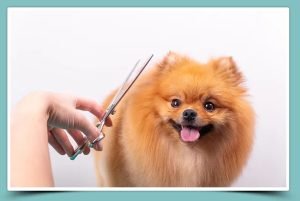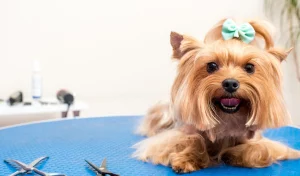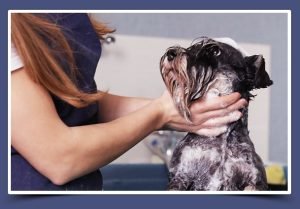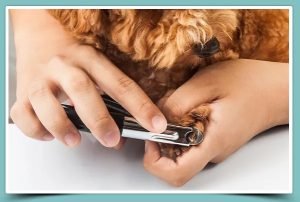Florence’s Beloved Pet Store Closes After Decades of Service
Florence’s Beloved Pet Store Closes Florence’s Beloved Pet Store Closes After Decades of Service The hearts of many pet lovers in Florence are heavy
<!-- Call Us Today at 470.979.8167 for Quality Mobile Grooming Services in Gwinnett & North Fulton--> Call Us Today at 470.979.8167 for Quality Mobile Services

As a pet owner, it’s easy to think that grooming is simply about keeping your dog looking cute and fresh. But did you know that regular grooming plays a vital role in your dog’s overall health and well-being? Beyond just aesthetics, grooming helps maintain your dog’s skin, coat, nails, and ears, while also preventing infections and even detecting health issues early. Let’s dive into the many health benefits of making grooming a regular part of your dog’s routine.
A healthy coat starts with regular grooming. Brushing your dog’s fur helps distribute natural oils throughout their coat, keeping their skin moisturized and reducing the risk of dryness or irritation. This is particularly important for breeds with long or dense coats, as they are prone to matting, which can trap moisture and bacteria, leading to skin infections.
Grooming also helps keep your dog’s coat clean by removing dirt, dead hair, and debris. Bathing, when done properly and with the right products, can remove allergens, dust, and grime, which helps keep your dog’s coat shiny and smooth.
Pro Tip: Regular brushing stimulates blood circulation, which encourages healthy hair growth, making your dog’s coat look vibrant and feel soft.
Dogs are susceptible to various infections, particularly in areas like their ears, skin, and paws. Regular grooming allows you to spot potential problems before they turn into serious health issues. For instance, ear cleaning helps prevent ear infections, which are common in floppy-eared breeds or dogs that spend a lot of time outdoors. By regularly inspecting and cleaning your dog’s ears, you can keep infections at bay.
Nail trimming is another grooming task that helps prevent infections. Overgrown nails can make it difficult for your dog to walk properly, leading to joint and posture issues. Worse, if nails are left too long, they can break or split, creating an open wound that could become infected. Trimming your dog’s nails regularly prevents this from happening and keeps their paws in tip-top shape.
Pro Tip: Look for signs of infection such as redness, discharge, or bad odors during your grooming routine. If you notice any of these symptoms, it’s time to consult your vet.
We all love our dogs, but shedding? Not so much. Regular grooming can help control shedding, particularly during seasonal changes when dogs tend to shed more. Brushing your dog’s coat at least a few times a week can significantly reduce the amount of loose fur they leave behind, keeping your home cleaner and helping to prevent mats from forming.
While it’s impossible to stop shedding entirely (it’s a natural process), regular brushing helps to remove loose fur before it falls off, and proper bathing and conditioning help maintain the health of your dog’s coat. For dogs with thick or double coats, this is especially important, as it prevents the undercoat from becoming too dense and causing discomfort.
Pro Tip: Using the right brush for your dog’s coat type is key. A slicker brush works wonders for long-haired breeds, while a bristle brush is perfect for short-haired dogs.
One of the biggest benefits of regular grooming is the opportunity to spot health problems early on. When you groom your dog consistently, you become familiar with their body and can notice any unusual changes such as lumps, bumps, skin rashes, or parasites like fleas and ticks. Early detection of these issues can prevent them from escalating into more serious conditions.
For instance, during grooming, you might notice a small lump that wasn’t there before. While it may be harmless, it’s always better to get it checked by a vet before it grows or becomes something more concerning. Regular grooming also allows you to monitor your dog’s weight, as you’ll notice if they’re losing or gaining weight unexpectedly.
Pro Tip: Take note of any changes in your dog’s skin, coat, or behavior during grooming sessions. Regular checks will help catch health issues early, giving your dog the best chance at treatment and recovery.
Nail trimming is an essential part of regular grooming that is often overlooked. Dogs with overgrown nails may experience pain when walking, as long nails can push back into their paw pads. This can lead to discomfort, limping, or even infections if the nails break or split.
Regular trimming helps prevent these issues and keeps your dog’s paws healthy. It also supports proper posture and balance, ensuring that your dog is comfortable while walking or running. For active dogs, well-trimmed nails are crucial to maintaining their mobility and comfort during physical activities.
Pro Tip: If you’re uncomfortable trimming your dog’s nails at home, ask a professional groomer for help or tips on how to safely handle this task.
While it’s nice to have a clean and well-groomed dog, regular grooming goes far beyond looks. It’s a crucial part of maintaining your dog’s health, preventing infections, reducing shedding, and detecting potential health issues early. By incorporating grooming into your routine, you’ll not only keep your dog looking their best but also ensure they’re feeling their best too.
Make grooming a bonding experience, whether it’s a quick brush every evening or a full grooming session every few weeks. Your dog will thank you for it with a healthier coat, fewer health problems, and a happier attitude.
Florence’s Beloved Pet Store Closes Florence’s Beloved Pet Store Closes After Decades of Service The hearts of many pet lovers in Florence are heavy
# Top 22 Dog Gifts Every Dog Lover Needs This Year Welcoming a new four-legged friend into your home or spoiling your long-time canine

Every dog breed has its own unique characteristics, and this extends to their grooming needs. While all dogs benefit from regular grooming, some breeds require

Dogs N Friends Introduces Mini Spa Package Duluth, GA — Pamper your furry friend with the all-new Mini Spa Package offered by Dogs N

As a pet owner, it’s easy to think that grooming is simply about keeping your dog looking cute and fresh. But did you know that

Full Body Trim and Deep Cleaning Package Duluth, GA — Pet owners in Duluth, GA, can now treat their furry companions to a luxurious grooming
Mobile Dog Grooming